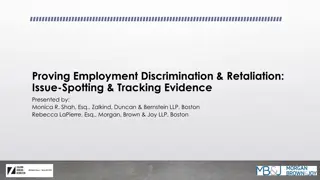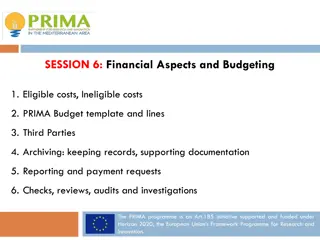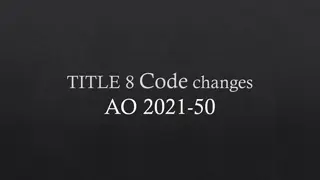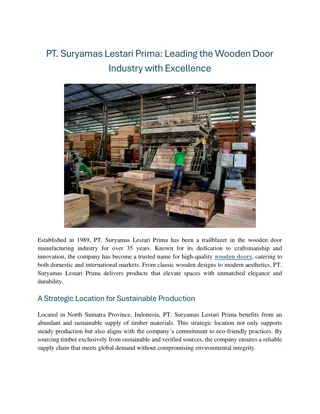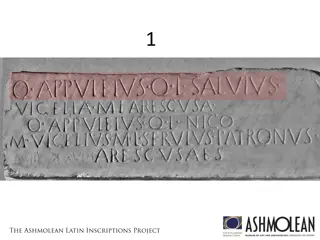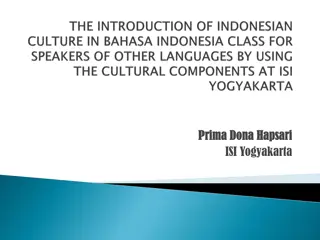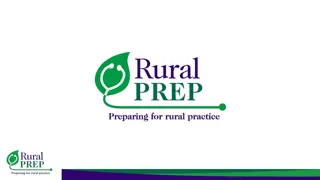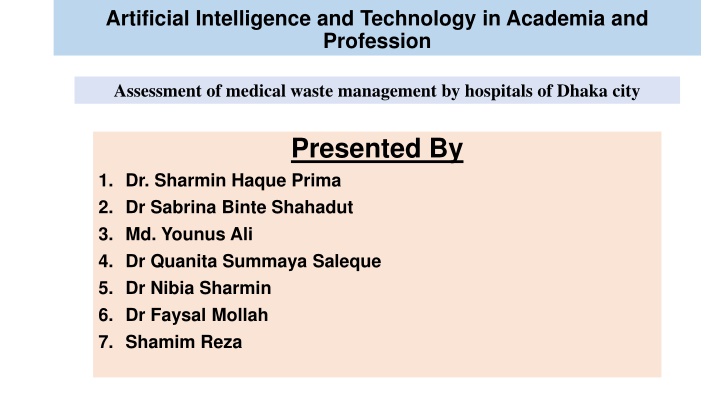
Assessment of Medical Waste Management in Dhaka City Hospitals
"Explore the challenges and classification of hospital waste in Dhaka city, from non-hazardous to hazardous waste. Discover the critical need for proper management to prevent public health risks and environmental harm."
Download Presentation

Please find below an Image/Link to download the presentation.
The content on the website is provided AS IS for your information and personal use only. It may not be sold, licensed, or shared on other websites without obtaining consent from the author. If you encounter any issues during the download, it is possible that the publisher has removed the file from their server.
You are allowed to download the files provided on this website for personal or commercial use, subject to the condition that they are used lawfully. All files are the property of their respective owners.
The content on the website is provided AS IS for your information and personal use only. It may not be sold, licensed, or shared on other websites without obtaining consent from the author.
E N D
Presentation Transcript
Artificial Intelligence and Technology in Academia and Profession Assessment of medical waste management by hospitals of Dhaka city Presented By 1. Dr. Sharmin Haque Prima 2. Dr Sabrina Binte Shahadut 3. Md. Younus Ali 4. Dr Quanita Summaya Saleque 5. Dr Nibia Sharmin 6. Dr Faysal Mollah 7. Shamim Reza
Hospital waste are the waste produced in the course of healthcare activities during treating diagnosing and immunizing human beings or animals or whole doing study / research activities. Hospital waste pose a serious public health problem. The problem is getting worse with the increasing number of hospital, clinic & diagnostic laboratories in Dhaka city. Inadequate and improper technique may cause serious health Hazard and environmental population. Non-hazardous waste does not pose special handling problems to human health or environment. In this study, non- hazardous waste is classified into two categories such as general waste and reusable waste. General waste includes food waste, paper waste, noninfectious materials, waste originated from catering services and administrative establishment On the other hand, hazardous waste is responsible for spreading of infections and epidemic diseases and should pose special care in handling. Clinical waste include blood bag, bloods contaminated saline/set, blood and body fluid contaminated materials, body parts/organs, catheter, clothes used by AID Sandbarrier s patients, drainage tube, gauge, bandage and cotton, surgical sponge etc.
On the other hand, sharp waste includes BP blades, broken glass, cover slip, infusion set, knives, needles, nozzle of syringe, scalpels blades etc. Source of health care waste: Government hospital, Private hospital, Nursing homes, Physician office, Dentist office, Dispensary, Mortuaries, Blood bank and collection centre, Animal house, Laboratories, Research organization.
The wastes generated during the process of diagnosis, treatment, operation, or-immunization or in research activities, are termed as medical wastes. It is an on going problem for many countries and poses a serious public health problem. Due to modernization of medical services and increased number of patients, healthcare institutions generate large amounts of medical wastes. Approximately 75 95% of bio-medical wastes are non-hazardous and the remaining 10 25% are hazardous to humans or animals and detrimental to the environment. It is very important to realize that if both of these types are mixed together, then all waste becomes harmful. Reports in the literature shows 80% of all medical wastes are mixed with general wastes. The World Health Organization (WHO) estimated that, during 2000, injections with contaminated syringes caused 21million hepatitis B virus infections, 2 million hepatitis C virus infections, and 260 000 cases of human immunodeficiency virus (HIV) infections. Cases with staphylococcal bacteriemia and endocarditis were reported among cleaning staff after needle injury. Healthcare providers (HCPs) are at risk of occupational dangers as they perform their jobs in hospitals. Serious diseases may develop in HCPs as well as patients and the general public. The highest rates of occupational injury among all workers who may be exposed to healthcare wastes were reported by cleaning personnel and waste handlers; the annual rate in the United States was 180 per 1000.Based on types of wastes and hospital category, medical waste management (MWM) scenarios at hospitals in Bangladesh are not satisfactory.
There are approximately 1300 government hospitals with 43 000 beds, including public specialized hospitals, medical college hospitals (tertiary level), district hospitals (secondary level), and upazila (primary level) health complexes in Bangladesh. Many private hospitals and clinics also provide healthcare. The waste generation rate for infectious waste and sharps waste from government hospitals were 0.11 and 0.03 kg/bed/day, respectively. Most health facilities do not have adequate and effective systemic approaches to medical waste disposal. The medical wastes are simply mixed withthe municipal wastes in the collecting bins at the road side and some percentage are buried without any pre-cautions or are burned in the open. The pollution of the environment with toxic substances is a serious public health problem in Bangladesh. Public awareness of healthcare wastes has grown recent years, especially with the emergence of acquiredimmunodeficiency syndrome (AIDS). Another study identified the types and amount of medical waste generation. There has been no published study among HCPs regarding awareness of knowledge and practices, and possible barriers to proper MWM in Bangladesh. The WHO recommended raising awareness of medical waste risks and promoting safe and sound practices to improve the situation. Therefore, it was necessary to conduct this study with the objective of assessing relevant knowledge and practices, and to identify possible barriers to proper MWM among HCPs. The association of knowledge and practices with back-ground characteristics was also evaluated.
Recommended colour coding for hospital waste. Colour of container and marking Type of waste Type of container Clinical waste Yellow Strong,leak-proofplasticbag or container Sharpswaste Red Puncture proof container Reusable waste Black Leak-proof plastic bagor container General waste Green Plastic bagor container
This chapter's primary goal is to concentrate on research methods appropriate for analysis. This study is aimed to assess the knowledge and practices regarding medical waste management (MWM) among healthcare providers (HCPs). This Cross Sectional Study was carried out to evaluate the level of medical waste management by hospitals of Dhaka city. The target population is Among healthcare professionals of different private and government hospital on Dhaka city. This approach employed a cross-sectional analysis with 379 patients in different private and government hospitals of Dhaka city, Bangladesh. This cross-sectional study was conducted from June to August 2023 among different level hospitals in Dhaka City, Bangladesh. The Sample-has collected by systemic random sampling method of positive cases.
One tertiary level hospital was selected purposively from Dhaka City In the first stage, 3 out of 17 district (secondary level) hospitals were selected using a simple random sampling (SRS) method. In the second stage, we also selected 3 upazila (primary level) hospitals, 1 from each of the above-mentioned districts, by applying the SRS. The Data were collected using a self-administered open & closed questionnaire. The data to be collected and analyzed using SPSS and presented in form of tables, pie charts and Bar graphs. The study was carried out in only a few selected government, non-government hospitals, clinics and diagnostic centres of Dhaka City mainly for HWM. Selected HCCs were considered and visited to quantify the hazardous and non-hazardous portion of HW generated in Dhaka.
Results & Discussion
Among 379 respondents 273(72.1%) male and 106 (27.9%) female. MALE FEMALE Figure: 01: Distribution of the participants by gender
Among 379 respondents maximum 105 (27.7%) belong to 21 to 30 years, 100(26.4%) belong to 31 to 40 years, 93(24.5%) belong to 41 to 50 years and 81(21.4%) belong to 51 to 60 years. Age group Number Percentage % 21 to 30 105 27.7% 31 to 40 100 26.4% 41 to 50 93 24.5% 51 to 60 81 21.4% Total 379 100% Table: 01: Distribution of the participants by age
On asking about religion majority of them 221(58.3%) Muslim, 140(36.9%) Hindu, 10(2.6%) Christian and 8(2.1%) Buddhist. Religion Muslim Number 221 Percentage % 58.3% Hindu 140 36.9% Christian 10 2.6% Buddhist 8 2.1% Total 379 100% Table: 02: Distribution of the participants by Religion.
Below figure showed that among 379 respondent 37(9.8%) primary level, 40(10.6%) secondary level, 63(16.6%) higher secondary, 140(36.9%) Graduation and 99(26.1%) Diploma on education. Figure: 02: Distribution of the participants by Education level
On asking about their occupational designation majority of them 102(26.9%) Nurse, 71(18.7%) Doctor, 88(23.2%) Paramedic, 100(26.4%) cleaner and 18(4.7%) other staff. Designation Doctor Number 71 Percentage % 18.7% Nurse 102 26.9% Paramedic 88 23.2% Cleaner 100 26.4% Others 18 4.7% Total 379 100% Figure: 03: Distribution of the participants by Designation.
On asking about any Hospital Waste Disposal Policy In their Hospital majority of them 341(89.9%) answered yes they have and 38(10.1%) answered No. On asking about Used disposal plastic items are disposal of 204(53.8%) answered yellow bags, 72(19%)red bags, 66(17.4%) blacks bags and 37(9.8%) answered don t know. Figure: 03: Distribution of the participants by Hospital Waste Disposal Policy Figure: 04: Distribution of the participants by Disposal plastic items
On asking about follow colour coding for hospital waste majority of them 322(84.9%) answered yes and 57(15.1%) answered no. Follow colour coding for hospital waste Number Percentage % Yes 322 84.9% No 57 15.1% Total 379 100% Table 4: Follow colour coding for hospital waste
On asking waste management education programs in their majority of them 311(82.1%) answered yes, 40(0.6%) answered no and 28(7.4%) no response. Figure:05: Distribution of the participants by Waste management education programs
On asking about solid waste recycling majority of them 205(54.8%) answered yes, 108(28.5%) No and 66(17.4%) not sure. Solid waste recycling Number Percentage % Yes 205 54.8% No 108 28.5% Not sure 66 17.4% Total 379 100% Table 5: Distribution of the participants by Solid waste recycling
A descriptive cross section study was done at Dhaka city, Bangladesh. The study population was health professional at hospital in Dhaka city, Bangladesh. 379 sample sizes were selected to assess the Knowledge, attitude and Practice regarding hospital waste management among them by face to face interview. Similar study showed that 36% of the clinics who participated in this study disposed their medical waste in a public garbage container provided by the municipal waste transportation service. Inadequate knowledge and poor practices were observed among HCPs Bangladesh. Inadequate knowledge and poor practices were more prevalent among technologists and cleaning staff than medical doctors and nurses. Insufficient PPE, lack of instruments for final disposal, lack of staff, lack of appropriate guidelines, and lack of incinerators were identified as the top 5 possible barriers. Practice-based training regarding MWM. Recommendation Improved waste management facility. Improved waste management knowledge for every staff. Organized waste management education programme.


